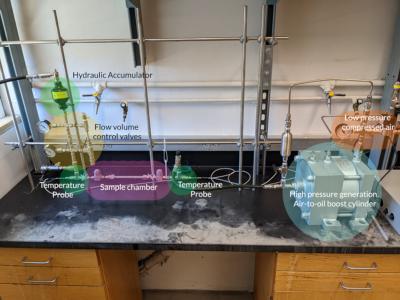Perovskite-Info weekly newsletter
Published: Tue, 08/23/22
The Perovskite-Info newsletter (August 23, 2022)
Cannot read this? View it online here
Researchers improve the efficiency of flexible perovskite solar cells using VdW stacking
Researchers from Sungkyunkwan University (SKKU), Korea University, Seoul National University and Korea's Frontier Energy Solution have demonstrated the feasibility of using the van der Waals stacking (vdWS) strategy to overcome the inefficiencies of flexible perovskite solar cells (f-PSCs).
The team explained that using halide perovskites can significantly increase the power conversion efficiency (PCE) of f-PSCs due to the low-temperature processability, ultrathin dimensions, low weight, and excellent optoelectronic properties of such cells. Several efforts were also made to develop the charge transporting layer (CTL), interface engineering between CTLs and perovskite, and highly-crystalline perovskite films on a flexible substrate, which further increased the f-PSC PCE to 22.44%. However, the efficiency is only 87% of the conventional glass-based PSCs. The f-PSC efficiency is affected by the physical process limitations caused by the flexible substrates' flexibility. Polymer substrates, such as polyethylene naphthalate (PEN) or polyethylene terephthalate (PET), or tin-doped indium oxide (ITO) are typically used as flexible substrates for f-PSCs.
Floating perovskite-based 'artificial leaves' generate clean fuels from sunlight and water
University of Cambridge scientists have developed perovskite-based floating ‘artificial leaves’ that generate clean fuels from sunlight and water. The team expects these could eventually operate on a large scale at sea. The ultra-thin flexible devices take their inspiration from photosynthesis. Since the low-cost, autonomous devices are light enough to float, they could be used to generate a sustainable alternative to gasoline without taking up space on land.

A floating artificial leaf which can generate clean fuel from sunlight and water – on the River Cam near King’s College Chapel in Cambridge, UK. Image credit: Virgil Andrei, from: Scitechdaily
Outdoor tests of the lightweight leaves on the River Cam showed that they can convert sunlight into fuels as efficiently as plant leaves. River Cam is the main river flowing through Cambridge in eastern England, and the testing occurred near iconic Cambridge sites including the Bridge of Sighs, the Wren Library, and King’s College Chapel.
Great Wall Holdings to build HQ and perovskite base for its spin-off UtmoLight in Wuxi, China
Great Wall Holdings (GWH) has entered a contract to build the headquarters and a perovskite base for its spin-off company UtmoLight in Wuxi, China.
The company signed an agreement with local authorities of Wuxi’s Xishan Economic & Technological Development Zone to invest 3 billion yuan (around USD$442.2 million) in the UtmoLight project. The new headquarters and perovskite innovation industrial base will reportedly house 'the world’s first GW-grade perovskite photovoltaic module and BIPV production line'. The production line of perovskite quantum dot will feature a production capacity of 100 tonnes per year. GWH expects to see an annual production value of 2.5 billion yuan ($368.5 million) after the base is up and running.
UNIST team develops ethanol-based solution for dense and uniform perovskite thin film
Researchers from Ulsan National Institute of Science and Technology (UNIST) have reported the deposition of dense and uniform α-formamidinium lead triiodide (α-FAPbI3) films using perovskite precursor solutions dissolved in ethanol-based solvent. This addresses the issue of halide perovskites generally not being completely soluble in most non-toxic solvents.
The research team, led by Seok Sang-il, has worked out an ethanol-based perovskite precursor solution by designing a complex compound structure so that perovskites can be dissolved well in ethanol. In their study, the researchers obtained power conversion efficiencies of 24.3% using a TiO2 electrode, and of 25.1% with a SnO2 electrode.
Researchers use perovskites to design more environmentally friendly air conditioners
Researchers have reported a prototype device that could someday replace existing air-conditioners. The device is more environmentally friendly and uses perovskite-based solid refrigerants to efficiently cool a space.

Currently used hydrofluorocarbon refrigerants used in air conditioners and other cooling devices are potent greenhouse gases and major drivers of climate change. This new work has the potential to tackle this issue and offer a greener solution.
New testing approach could promote commercialization of perovskite solar cells
Researchers from the University of Melbourne, Monash University and IEK-5 Photovoltaik in Germany have developed a large-area laser beam induced current microscope that has been adapted to perform intensity modulated photocurrent spectroscopy (IMPS) in an imaging mode. The new imaging tool could reportedly spot previously undetectable defects in solar cells.
The team's IMPS microscopy was used to study the spatial dependence of moisture-related degradation in a back-contact PSC. Using diffusion-recombination theory, the researchers modeled the IMPS response from which ambipolar diffusion length maps can be extracted from low-frequency experimental data. Apart from this important metric, they illustrated how other frequency bands can be used to study the degradation of a PSC.
Metalgrass LTD
9 Har Tsin St.
Kfar Sava Hasharon 4430809
ISRAEL
Unsubscribe | Change Subscriber Options




